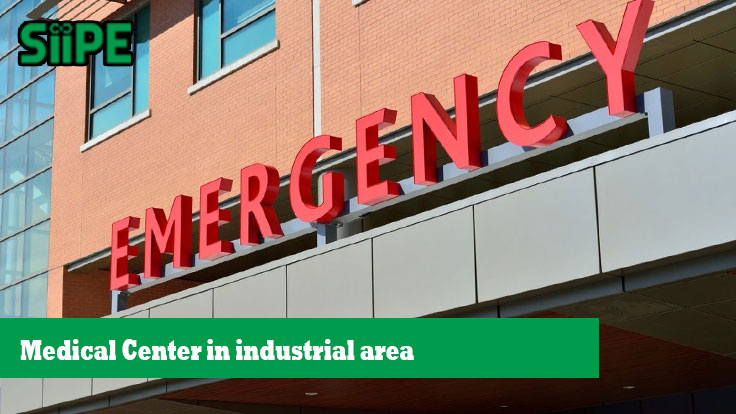As industrial areas grow and evolve, there is an increasing recognition of the need for comprehensive healthcare solutions within these zones. Traditionally, medical facilities were considered secondary in the context of industrial development, but the modern approach underscores their critical role in maintaining workforce health and ensuring operational efficiency. Integrating medical centers directly into industrial areas represents a progressive strategy that aligns with contemporary health management practices, boosts productivity, and enhances overall worker well-being. This article explores the benefits, implementation strategies, and examples of medical centers within industrial areas, highlighting why this integration is essential for the future of industrial development.
Why Medical Centers in Industrial Areas?
1. Improved Worker Health and Safety
Industrial environments often involve exposure to various health risks, from chemical hazards to physical injuries. On-site medical centers provide immediate access to healthcare, allowing for quicker response times in emergencies and regular health check-ups. This proximity can significantly reduce the severity of injuries and illnesses, ensuring that workers receive timely medical attention and preventive care.
2. Enhanced Productivity
Worker health directly impacts productivity. When employees are healthy and receive prompt medical care, absenteeism and presenteeism (working while ill) decrease, leading to higher productivity. Medical centers within industrial areas can conduct regular health screenings, manage chronic conditions, and address work-related health issues, thus keeping the workforce in optimal condition and reducing downtime.
3. Regulatory Compliance and Risk Management
Many countries have stringent regulations regarding workplace health and safety. By integrating medical centers into industrial areas, companies can better comply with these regulations, manage health risks, and avoid potential legal issues. On-site medical facilities ensure that health and safety standards are met, and they help in documenting and managing occupational health records.
4. Cost Savings
While the initial investment in setting up a medical center might seem high, it can lead to significant long-term savings. By reducing workplace accidents, managing health conditions proactively, and minimizing the need for external medical visits, companies can lower healthcare costs and reduce insurance premiums. Preventive care and early intervention also help in avoiding expensive treatments for advanced conditions.
Implementing Medical Centers in Industrial Areas
1. Design and Infrastructure
The design of a medical center within an industrial area should prioritize accessibility and functionality:
- Strategic Location: The center should be strategically located to ensure easy access for all employees. It should be centrally situated to minimize travel time and disruption during emergencies.
- Comprehensive Facilities: The center should be equipped with essential medical facilities, including emergency care units, examination rooms, diagnostic equipment, and pharmacy services. It should also have comfortable waiting areas and administrative offices for efficient management.
- Ergonomic and Safety Features: The design should incorporate ergonomic principles to ensure the safety and comfort of both patients and medical staff. Safety features such as proper ventilation, sanitation facilities, and waste disposal systems are crucial in maintaining a hygienic environment.
2. Staffing and Training
Staffing the medical center with qualified healthcare professionals is essential:
- Healthcare Providers: Employ a team of skilled professionals, including doctors, nurses, and occupational health specialists, who are trained to handle industrial health issues and emergencies.
- Continuous Training: Provide ongoing training for medical staff to keep them updated on the latest medical practices and safety protocols. Training should also extend to employees on basic first aid, health awareness, and emergency procedures.
3. Integration with Industrial Operations
Integrating the medical center into the industrial operations involves coordination with various departments:
- Health and Safety Programs: Collaborate with the company’s health and safety department to align the medical center’s services with existing safety programs. This includes participating in safety drills, health screenings, and wellness programs.
- Data Management: Implement a robust health information system to track and manage employee health records, monitor trends, and ensure compliance with health regulations. Data security and confidentiality are paramount.
- Emergency Response Planning: Develop and regularly update emergency response plans, including protocols for handling industrial accidents, chemical exposures, and other health crises. The medical center should play a key role in these plans, ensuring that staff are trained and prepared for emergencies.
4. Community and Employee Engagement
Engaging with employees and the local community fosters a positive health culture:
- Health Education: Offer educational programs and workshops on topics such as nutrition, stress management, and preventive care. Engage employees in health promotion activities and encourage participation in wellness initiatives.
- Feedback Mechanisms: Establish channels for employees to provide feedback on the medical center’s services and suggest improvements. Regularly review this feedback to ensure that the center meets the needs of the workforce.
Examples of Medical Centers in Industrial Areas
1. Siemens Healthineers – Erlangen, Germany
Siemens Healthineers, a leading healthcare technology company, has integrated a state-of-the-art medical center within its industrial complex in Erlangen. The facility offers comprehensive healthcare services, including primary care, emergency care, and occupational health services. The center’s strategic location within the industrial area allows for rapid response to health issues, contributing to improved worker health and productivity.
2. Tesla – Fremont, California, USA
Tesla’s Fremont factory includes an on-site medical center designed to address the health needs of its large workforce. The center provides occupational health services, emergency care, and wellness programs. It also plays a critical role in managing work-related injuries and health conditions, ensuring that Tesla’s employees remain healthy and productive.
3. Tata Steel – Jamshedpur, India
Tata Steel’s Jamshedpur plant features a comprehensive medical center that offers a range of services, including emergency care, preventive health screenings, and specialized treatments. The center is part of Tata Steel’s commitment to employee well-being and safety, reflecting the company’s dedication to maintaining a healthy workforce in a high-risk industrial environment.
Integrating Medical Centers
Integrating medical centers into industrial areas represents a forward-thinking approach to workforce health management. By providing on-site medical care, companies can enhance worker safety, boost productivity, and achieve cost savings while ensuring compliance with health regulations. The strategic design, staffing, and integration of these facilities are crucial for their success.
As demonstrated by leading companies around the world, investing in medical centers within industrial areas is not only a smart business decision but also a commitment to the well-being of employees and the overall efficiency of industrial operations. As industrial areas continue to grow and evolve, the integration of comprehensive healthcare solutions will become an increasingly essential component of modern industrial development.











